Recent Articles
Popular Makes
Body Types
2021 Kia Sorento Hybrid Road Test and Review
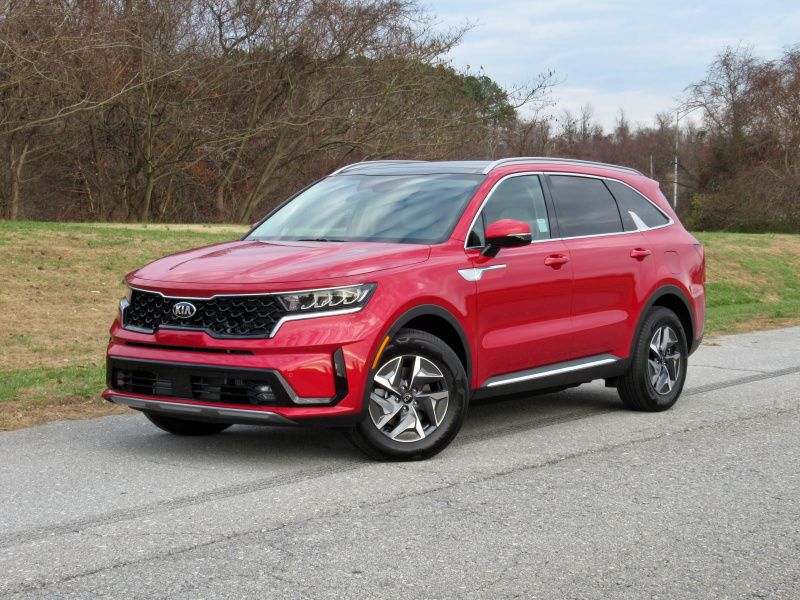
2021 Kia Sorento Hybrid ・ Photo by Brady Holt
Some cars are obvious compromises. To get one thing you want, you need to give up something else. Sometimes, though, you may not have to give up very much to get a lot of desirable advantages.
Take the all-new 2021 Kia Sorento Hybrid. This mid-size crossover SUV has three rows of seats, gas mileage that can top 40 miles per gallon, a long list of standard features, and a base price in the low $30,000s. It retains the Sorento’s polished driving experience and solid value for the money — it costs just $1,700 more than a comparable gas-only Sorento — while adding a seamlessly fuel-sipping powertrain. True, the Sorento Hybrid is missing some features you can get on the gas-only Sorento and other mid-size crossovers; all-wheel drive is a particularly glaring omission. But as long as you don’t mind front-wheel drive, join us as we discuss the pros and cons of the new Sorento Hybrid.
How It Works
Like most hybrids, the Kia Sorento Hybrid combines an electric motor with a gasoline engine to save fuel. The electric motor can help the gasoline engine — making it work less hard and burn less gas — or even take over entirely sometimes when you’re coasting or accelerating gently. The electric battery recharges as you drive, getting energy from the gas engine and braking friction. A plug-in hybrid model, which lets you charge a larger battery with electricity from the power grid, is due in 2021.
The Sorento Hybrid is unusual in that its gasoline engine is a 1.6-liter turbocharged four-cylinder, and that it uses a conventional six-speed automatic transmission. Most competitors have naturally aspirated engines and continuously variable automatic transmissions. The Kia’s approach provides a more natural driving experience while still cutting fuel costs; EPA estimates are 39 mpg in the city, 35 mpg on the highway, and 37 mpg overall. We averaged 38 mpg overall, trouncing the city estimate in stop-and-go conditions and other lower-speed driving, but only managed about 30 mpg on the open freeway. This is the perfect hybrid for your rush-hour commute, but maybe not your family road trip.
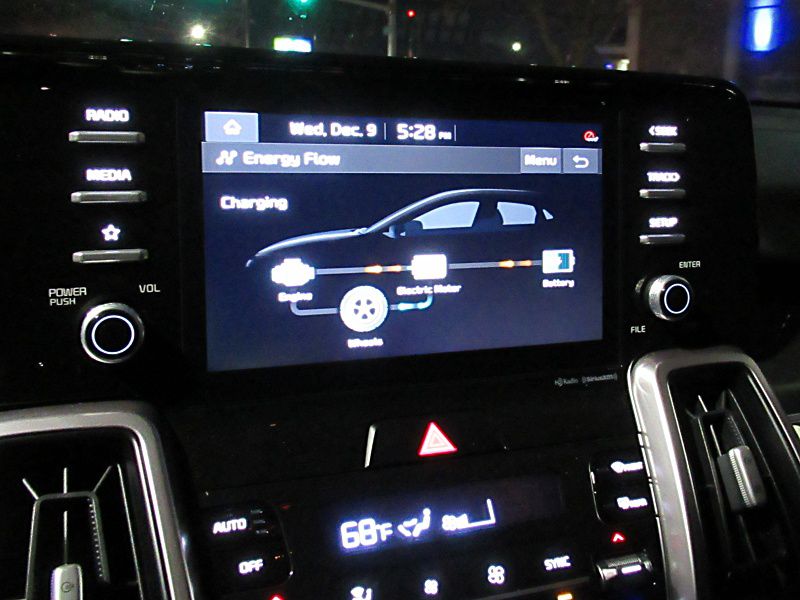
Photo by Brady Holt
Crisp Exterior
The 2021 model year brings an all-new version of the Sorento, which is often Kia’s best-selling model. Kia kept the dimensions nearly identical to the old Sorento, which makes it one of the smallest three-row crossovers you can buy. (Kia sells the larger Telluride as a closer rival to the Ford Explorer, Chevrolet Traverse, and Honda Pilot.) But a crisper new body keeps the 2021 Sorento up to date.
While the old Sorento was a rounded-off box with curved headlights and taillights, the new model has straighter lines and sharper creases. It’s not exactly a daring look, but the headlights and grille have intricate details, and unusual touches include two-part taillights (with a vertical gap running down the middle) and a chrome wave on each side window behind the rear door. The hybrid model has different alloy wheels than non-hybrid Sorento models, but otherwise, a small “Eco Hybrid” badge is the main visual clue that this vehicle is partially powered by electricity.
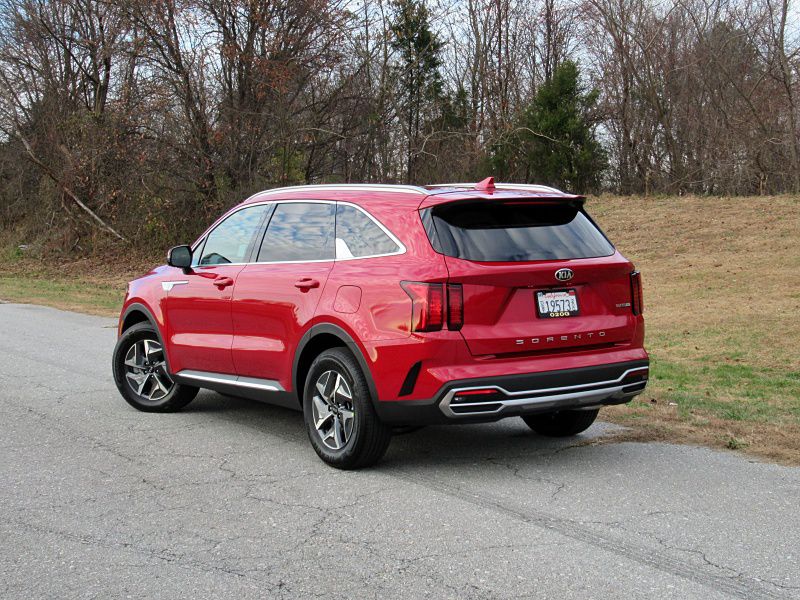
Photo by Brady Holt
Rugged, High-Tech Interior
The new Sorento has a rugged vibe to its dashboard design, with chunky rectangles dominating the cabin. The control layout is simple, and most functions are easy to figure out and use, though the touch-sensitive climate controls are an unnecessary frustration. Materials aren’t super-plush but feel solid without coming off as cheap, and trim pieces fit together well.
Every Sorento Hybrid uses an 8-inch touchscreen infotainment system with Android Auto and Apple CarPlay — a still-rare wireless version of the system that lets you use smartphone apps through the car’s screen without even plugging in your phone. Upper-trim vehicles add a wireless phone charger as well, so you’ll never need a cable. However, no Sorento Hybrid gets the extra-generous 10.25-inch screen found on top-of-the-line gas-powered Sorento models. That’s a disappointing oversight on a high-tech hybrid.
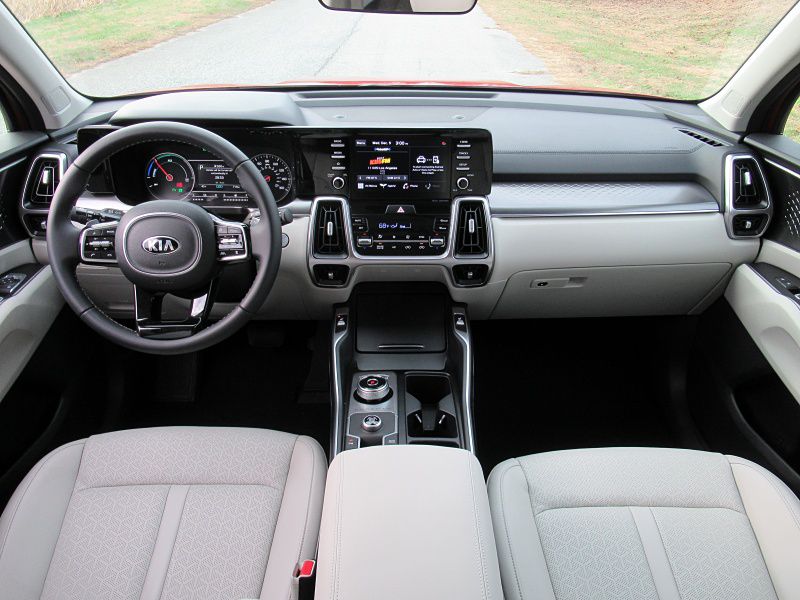
Photo by Brady Holt
Seating for Six
Every 2021 Kia Sorento Hybrid seats six passengers: two in the front seat, two in second-row captain’s chairs, and two in the third-row bench seat. Adults can be comfortable in the first two rows — an improvement over last year’s Sorento line, where the second-row seat would have benefited from more legroom. Synthetic leather upholstery with heated front seats comes standard on all Sorento Hybrids.
The third row is quite small, but we were able to squeeze inside even with the fore-aft-adjustable second-row seats all the way back. Adults will never be comfortable, but many SUVs are even worse; the Sorento Hybrid can at least sit six in a pinch, and children shouldn’t have to complain too much. Cargo space is quite limited behind the third row, though, at 12.6 cubic feet. It folds easily to provide a reasonable 38.5 cubic feet, and maximum capacity with all rear seats folded is 75.5 cubic feet. Without the option for a second-row bench seat, though, the Sorento Hybrid misses its chance to seat up to seven passengers, or to seat five when the third row is folded down. Maximum towing capacity is 2,000 pounds.

Photo by Brady Holt
Enjoyable Driving Experience
With a smooth gasoline engine, seamless transitions between gas and electric operations, and a peppy 227 horsepower and 258 lb-ft of torque, the Sorento Hybrid provides strong, quiet acceleration. There’s none of the moaning drone you’ll find in some other hybrids, which sound like they’re straining even if they’re actually quick.
The Sorento Hybrid also has enjoyable ride and handling characteristics. It feels solid and stable, and also small enough to be easily maneuverable and agile. It’s not a sporty SUV, but its steering is natural and generally well-weighted; it doesn’t feel disconnected from the wheels. This isn’t the cushiest-riding crossover you’ll find, but nor is it unnecessarily stiff. And bumps don’t upset its composure the way they do in some soft-sprung SUVs — the Sorento Hybrid quickly absorbs the impacts and recovers quickly. The main downside is that it’s not especially quiet on the highway, with less-than-hushed wind and road noise.

Photo by Brady Holt
Safety Comes Standard
The Sorento Hybrid comes with a long list of standard safety features. Even the base S model provides a forward-collision warning with automatic emergency braking and pedestrian-detection capability, a lane-departure warning with lane-keep assistance, a driver-attention warning, a leading-vehicle-departure warning (it beeps when the car in front of you drives away before you finish sending that stoplight text), automatic high beams, blind-spot monitoring with a rear cross-traffic alert, and rear parking sensors.
The upper-trim EX adds adaptive cruise control, front parking sensors, and a more sophisticated forward-collision warning — it can detect bicyclists and traffic approaching on a cross street. However, no Sorento Hybrid includes the surround-view parking camera that’s available on the gas-only Sorento. Crash-test results aren’t yet available, but even last year’s Sorento earned excellent scores.
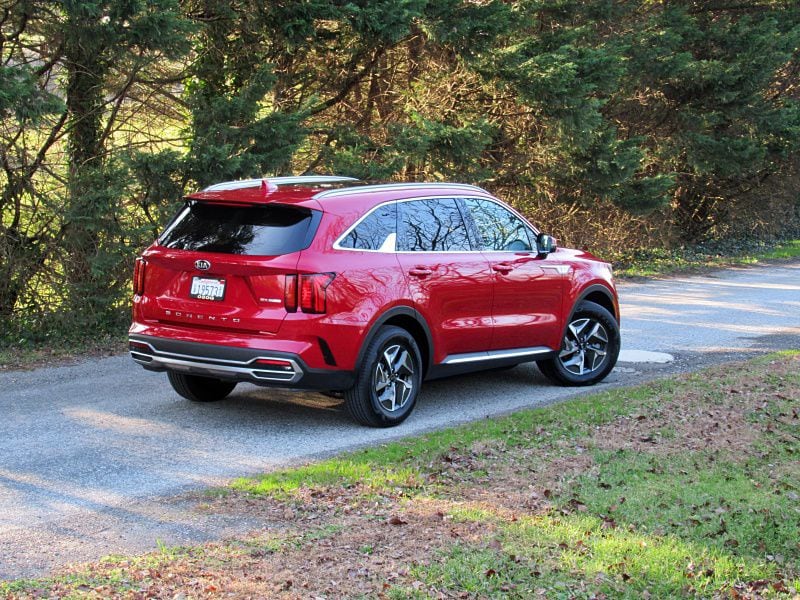
Photo by Brady Holt
Two Similar Trim Levels
The gas-only Kia Sorento is available with a choice of five trim levels. The Sorento Hybrid, though, is limited to two trims from the middle of the gas Sorento range: the S ($33,590) and the EX ($36,590). That’s an upcharge of less than $2,000 from the equivalent gas-only Sorento trims, even though the hybrids also include additional equipment: second-row captain’s chairs on the S and a panoramic sunroof on the EX.
As we mentioned, both Sorento Hybrid vehicles have leatherette upholstery, 8-inch touchscreens, front-wheel drive, and a generous suite of safety features. In addition to the more sophisticated driver aids we mentioned, the EX adds the panoramic sunroof as well as a power liftgate and a wireless smartphone charger.
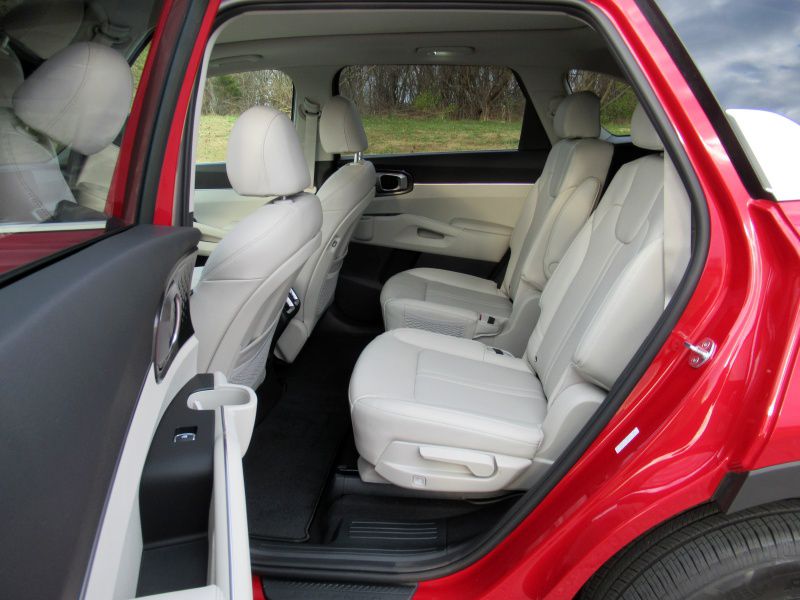
Photo by Brady Holt
Competitors to Consider
The Kia Sorento Hybrid slots in size and price between two popular Toyota hybrids: the five-seat Toyota Venza and the three-row Toyota Highlander Hybrid. The Kia offers superior ride, handling, and acceleration, but the Venza has more features for the money and better gas mileage, while the Highlander Hybrid has more room and a longer list of available luxury features.
Another rival is on the way soon: an upcoming Hyundai Santa Fe Hybrid. It’s the Kia’s corporate cousin, with the same mechanical equipment but different exterior and interior styling. The Santa Fe doesn’t offer third-row seating, but it will fit five passengers in its two rows — plenty for many buyers. And buyers can also consider the gas-only Sorento, which also gets respectable gas mileage for a three-row crossover: up to 26 mpg in mixed driving.
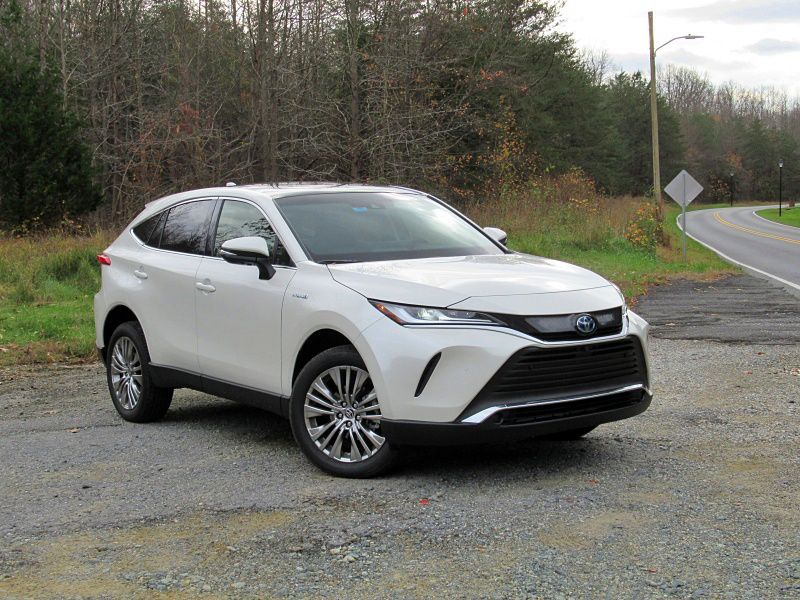
Photo by Brady Holt
Intriguing New Choice
The all-new 2021 Kia Sorento Hybrid provides great gas mileage without sacrificing power and refinement, and three rows of seats without forcing you into a bulky, expensive vehicle.
Launching a new suv without the option for all-wheel drive is a puzzling choice, and one that will surely cost Kia some customers. But if you were already going to decline the AWD option on a gas-powered Sorento — and you don’t spend most of your driving time on empty Interstates, where its mileage is less impressive — it’s almost a no-brainer to pay a little extra for the Sorento Hybrid’s far superior fuel economy. And no matter which front-drive mid-size crossover you’re interested in, the Sorento Hybrid is an intriguing option to consider.

Photo by Brady Holt